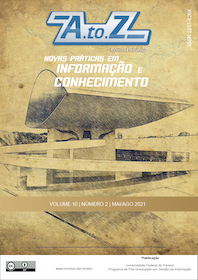Using ClassDojo to motivate kids participation in the efl online classes during the Covid-19 pandemic: a case study
DOI:
https://doi.org/10.5380/atoz.v10i2.78711Palabras clave:
ClassDojo, Class participation, Motivation, Online classes, COVID-19Resumen
Introduction: COVID-19 pandemic has changed the way the classes were conducted worldwide. Ecuadorian teachers were required to implement synchronously and asynchronously classes. Consequently, all the content was adapted to this new type of class. On the other hand, students have presented tiredness during classes, demotivation to learn, and unhappiness with this new modality. Studies have demonstrated the advantages of Computer Assisted Language Learning (CALL) to motivate learners. Method: This case study aimed to investigate the efficiency of ClassDojo to motivate Ecuadorian students' participation during the English online classes. A sample of 29 sixth-graders from a private school, ranging from 9 to 11 years old, participated in this research. The data were collected during four months of classes (August to November 2020) through tests (pre and post), interview, and teacher's journal. Results: After the implementation of the app, the participants presented a significant difference between the pre-test (M= 2.03, SD= 1.26) and post-test (M= 7.28, SD= 1.69) with a p = 0.00 and Cohen’s d=3.52. The results gathered from the pre and post-test revealed that ClassDojo motivated students' participation in class. Results from the interview showed students' positive opinions on the use of ClassDojo. Conclusions: This app allowed participants to learn, interact, and have fun at the same time. This research is addressed to teachers who have online classes and want to increase learners' participation.
Citas
Adams, A., Randall, S., & Traustadóttir, T. (2015). A tale of two sections: An experiment to compare the effectiveness of a hybrid versus a traditional lecture format in introductory microbiology. CBE Life Sciences Education, 14(1), 1-8. https://doi.org/10.1187/cbe.14-08-0118
Alqurashi, E. (2019). Predicting student satisfaction and perceived learning within online learning environments. Distance Education, 40(1), 133-148. https://doi.org/10.1080/01587919.2018.1553562
Armstrong, M., & Boud, D. (1983). Assessing participation in discussion: An exploration of the issues. Studies in Higher Education, 8(1), 33–44. https://doi.org/10.1080/03075078312331379101
Auster, C., & MacRone, M. (1994). The classroom as a negotiated social setting: An empirical study of the effects of faculty members' behavior on students' participation. Teaching Sociology, 22, 289-300. https://doi.org/10.2307/1318921
Baber, H. (2020). Determinants of Students' Perceived Learning Outcome and Satisfaction in Online Learning during the Pandemic of COVID19. Journal of Education and eLearning Research, 7(3): 285-292. https://ssrn.com/abstract=3679489
Bao, W. (2020). COVID-19 and online teaching in higher education: A case study of Peking University. Human Behavior and Emerging Technologies, 2(2), 113-115.: https://doi.org/10.1002/hbe2.191
Barata, G., Gama, S., Jorge, J., & Gonçalves, D. (2013). Improving participation and learning with gamification. In L. Nacke, K. Harrigan, & N. Randall (Eds.), Proceedings of International Conference on Gameful Design, Research, and Applications (pp. 10–17). ACM.
Baxter, P., & Jack, S. (2008). Qualitative case study methodology: Study design and implementation for novice researchers. The Qualitative Report, 13(4), 544-559. http://www.nova.edu/ssss/QR/QR13-4/baxter.pdf
Bean, J., & Peterson, D. (1998). Grading classroom participation. New Directions for Teaching and Learning, 74(15), 33 40. https://doi.org/10.1002/tl.7403
Bisson, C., & Luckner, J. (1996). Fun in Learning: The Pedagogical Role of Fun in Adventure Education. Journal of Experiential Education, 19(2), 108–112. https://doi.org/10.1177/105382599601900208
Bolliger, D. U., Supanakorn, S., & Boggs, C. (2010). Impact of podcasting on student motivation in the online learning environment. Computers & Education, 55(2), 714-722. https://doi.org/10.1016/j.compedu.2010.03.004
Brewer, R., Anthony, L., Brown, Q., Irwin, G., Nias, J., Tate, B. (2013). Using Gamification to Motivate Children to Complete Empirical Studies in Lab Environments. In: 12th International Conference on Interaction Design and Children, pp. 388–391.
Burchfield, C., & Sappington, J. (1999) Participation in classroom discussions. Teaching of Psychology, 26(4), 290–291.
Cáceres-Piñaloza, K. (2020). Educación virtual: Creando espacios afectivos, de convivencia y aprendizaje en tiempos de COVID-19. CienciAméRica, 9(2), 38-44. https://doi:10.33210/ca.v9i2.284
Cetin, H., & Cetin, I. (2018). Views of middle school students about Class Dojo education technology. Acta Didactica Napocensia, 11(3/4), 89-96. https://doi.org/10.24193/adn.11.3-4.7
Cole, M., Feild, H., & Harris, S. (2004). Student learning motivation and psychological hardiness: Interactive effects on students' reactions to a management class. Academy of Management Learning & Education, 3(1), 64-85. https://doi.org/10.5465/amle.2004.12436819
Crawford, M., & MacLeod, M. (1990). Gender in the college classroom: An assessment of the 'chilly climate' for women. Sex Roles, 23, 101-122. https://doi.org/10.1007/BF00289859
Daniels, A. (2004). Composition instruction: Using technology to motivate students to write. Information Technology in Childhood Education Annual, 2004(1), 157-177. https://www.learntechlib.org/primary/p/12898/
Dattilo, J., & Kleiber, D. A. (1993). Psychological perspectives for therapeutical recreation research: the psychology of enjoyment. In J. Marjorie & C. Z. Howe (Eds.), Research in therapeutic recreation: Concepts and methods (pp. 57-76). Venture Publishing.
Deterding, S., Dixon, D., Khaled, R., & Nacke, L. (2011). From game design elements to gamefulness: defining gamification. In Proceedings of the 15th International Academic MindTrek Conference (pp. 9–15).
Dicheva, D., Dichev, C., Agre, G., & Angelova, G. (2015). Gamification in Education: A Systematic Mapping Study. Educational Technology & Society, 18(3), 75–88. www.jstor.org/stable/jeductechsoci.18.3.75
Domínguez, A., Saenz-de-Navarrete, J., de-Marcos, L., Fernández-Sanz, L., Pagés, C., & Martínez-Herráiz, J. J. (2013). Gamifying learning experiences: Practical implications and outcomes. Computers & Education, 63, 380–392. https://doi.org/10.1016/j.compedu.2012.12.020
Dornyei, Z. & Otto, I. (1998). Motivation in action: A process model of L2 motivation. Working Papers in Applied Linguistics 4, 43 – 69. http://eprints.nottingham.ac.uk/id/eprint/39
Friedemann, S.; Baumbach, L. and Jantke, K. (2015). Textbook Gamification - Transforming Exercises into Playful Quests by using Webble Technology. In Proceedings of the 7th International Conference on Computer Supported Education, 2, 116-126. https://doi.org/10.5220/0005489101160126
Gardner, R. (1985). Social psychology and second language learning: The role of attitudes and motivation. London.
Gardner, R., Masgoret, A., Tennant, J., & Mihic, L. (2004). Integrative motivation: Changes during a year-long intermediate level language course. Language Learning, 54(1), 1-34. https://doi.org/10.1111/j.1467-9922.2004.00247.x
Gehlbach, H., & Robinson, C. (2018). Mitigating Illusory Results through Preregistration in Education, Journal of Research on Educational Effectiveness, 11(2), https://doi.org/10.1080/19345747.2017.1387950
Halim, M., Hashim, H., & Yunus, M. (2020). Pupils' motivation and perceptions on ESL lessons through online quiz-games. Journal of Education and E-Learning Research, 7(3), 229-234. https://doi.org/10.20448/journal.509.2020.73.229.234
Harmon-Jones, E., Harmon-Jones, C., & Price, T. (2013). What is approach motivation? Emotion Review, 5(3), 291-295. https://doi.org/10.1177/1754073913477509
Heller, J., Puff, C., & Mills, C. (1985). Assessment of the chilly college climate for women. Journal of Higher Education, 56, 446-461. https://doi.org/10.2307/1981305
Holliday, A. (2005). Doing and writing qualitative research. London: Sage Publications.
Hsu, H., Wang, C., & Levesque-Bristol, C. (2019). Reexamining the impact of self-determination theory on learning outcomes in the online learning environment. Education and Information Technologies, 24(3), 2159-2174. https://doi.org/10.1007/s10639-019-09863-w
Inoue, Y. (2007). Online education for lifelong learning: A silent revolution. In Online education for lifelong learning (pp. 1-27): IGI Global.
Jones, S. (2006). Evaluation of instructor knowledge on structuring and facilitating effective online discourse. The Journal of Educators Online, 3(2), 1-14. https://doi.org/10.9743/jeo.2006.2.1
Krach, S., McCreery, M., & Rimel, H. (2017). Examining Teachers' Behavioral Management Charts: a Comparison of Class Dojo and Paper-Pencil Methods. Contemporary School Psychology, 21(3):267–75. https://doi.org/10.1007/s40688-016-0111-0
Ku, H., Tseng, H., & Akarasriworn, C. (2013). Collaboration factors, teamwork satisfaction, and student attitudes toward online collaborative learning. Computers in Human Behavior, 29(3), 922-929. https://doi.org/10.1016/j.chb.2012.12.019
Lightbown, P., & Spada, N. (1993). How languages are learned. Oxford University Press.
Lin, N. (2014). Assessing Classroom Participation and Performance through Gamification Systems in Foreign Language Classrooms. In M. Searson & M. Ochoa (Eds.), Proceedings of SITE 2014--Society for Information Technology & Teacher Education International Conference (pp. 1772-1777). Association for the Advancement of Computing in Education (AACE). https://www.learntechlib.org/primary/p/131031/
Lowman, J. (1995). Mastering the techniques of teaching. Jossey-Bass.
Lyons, P. (1989). Assessing classroom participation. College Teaching, 37, 36-38. https://doi.org/10.1080/87567555.1989.10532154
Maclean-Blevins, A., & Muilenburg, L. (2013). Using ClassDojo to support student self-regulation. In J. Herrington, A. Couros, & V. Irvine et al. (Eds.), Proceedings of World Conference on Educational Multimedia, Hypermedia and Telecommunications (pp. 1684–1689). Association for the Advancement of Computing in Education. https://www.learntechlib.org/primary/p/112192/
Marks, R., Sibley, S., & Arbaugh, J. (2005). A structural equation model of predictors for effective online learning. Journal of Management Education, 29(4), 531-563. https://doi.org/10.1177/1052562904271199
McKinney, K., & Graham-Buxton, M. (1993). The use of collaborative learning groups in the large class: Is it possible? Teaching Sociology, 21, 403-408. https://doi.org/10.2307/1319092
Mercer, N., & Howe, C. (2012). Explaining the dialogic processes of teaching and learning: The value and potential of sociocultural theory. Learning, Culture and Social Interaction, 1(1), 12–21. https://doi.org/10.1016/j.lcsi.2012.03.001
Michael, F., Maithya, R., & Cheloti, S. (2016). Influence of teacher competency on integration of ICT in teaching and learning in public secondary schools in Machakos. Journal of Education and e-Learning Research, 3(4), 143-149. https://doi.org/10.20448/journal.509/2016.3.4/509.4.143.149
Middleton, J. A., Littlefield, J., & Lehrer, R. (1992). Gifted students' conceptions of academic fun: an examination of a critical construct for gifted education. Gifted Child Quarterly, 36(1), 38-44 https://doi.org/10.1177/001698629203600109
Muthuprasad, T., Aiswarya., S, Aditya, K., & Jha, G. (2020). Students' Perception and Preference for Online Education in India During COVID -19 Pandemic. Social Sciences & Humanities Open, 1-38. http://dx.doi.org/10.2139/ssrn.3596056
Nah, F., Zeng, Q., Telaprolu, V., Ayyappa, A., & Eschenbrenner, B. (2014). Gamification of Education: A Review of Literature. HCI in Business: First International Conference, Crete, Greece. Proceedings. 401-409. http://dx.doi.org/10.1007/978-3-319-07293-7_39
Nelson, M., Oden, K., & Williams, L. (2019). Student motivation to participate in asynchronous online discussions. Journal of Nursing Education and Practice, 9(9), 6-11. https://doi.org/10.5430/jnep.v9n9p6
Precourt, E., & Gainor, M. (2018): Factors affecting classroom participation and how participation leads to a better learning, Accounting Education: 1,100-118. https://doi.org/10.1080/09639284.2018.1505530
Rodrigues, H., Almeida, F., Figueiredo, V., & Lopes, S. L. (2019). Tracking e-learning through published papers: A systematic review. Computers & Education, 136, 87-98. https://doi.org/10.1016/j.compedu.2019.03.007
Saghafi, M. R., Franz, J., & Crowther, P. (2014). An integrated blended model for the contemporary learning environments. Journal of Interactive Learning Research, 25(4), 531-549. https://www.learntechlib.org/primary/p/40402/
Sebastianelli, R., Swift, C., & Tamimi, N. (2015). Factors affecting perceived learning, satisfaction, and quality in the online MBA: A structural equation modeling approach. Journal of Education for Business, 90(6), 296-305. https://doi.org/10.1080/08832323.2015.1038979
Thalheimer, W., & Cook, S. (2002). How to calculate effect sizes from published research: A simplified methodology. A Work-Learning Research Publication. www.work-learning.com
Tiberius, R. (1990). Small group teaching: A trouble-shooting guide. Ontario Institute for Studies in Education Press.
Weaver, R., & Qi, J. (2005). Classroom Organization and Participation: College Students' Perceptions. The Journal of Higher Education, 76(5), 570-601. http://www.jstor.org/stable/3838840
Weisz, E. (1990). Energizing the classroom. College Teaching, 38, 74-76. https://www.jstor.org/stable/27558400
Descargas
Publicado
Cómo citar
Número
Sección
Licencia
La revista AtoZ es una revista científica de acceso abierto y los derechos de autor de artículos y entrevistas pertenecen a sus respectivos autores/encuestados. Los autores otorgan a la AtoZ el direito de incluir el material publicado (revisado por pares/pos-print) en em sistemas/herramientas de indización, agregadores o curadores.
Los autores tienen permiso y se les anima a depositar sus artículos en sus páginas personales, depósitos y/o portales institucionales anteriormente (pre-print) y posteriormente (post-print) a la publicación en esa Revista. Se pide, si possible, que se apunte la referencia bibliográfica del artículo (incluyendose la URL) en base a la AtoZ.
La AtoZ es sello verde por Diadorim/IBICT.
Todo el contenido de la revista (incluyendo las instrucciones, modelos y política editorial) a menos que se indique otra cosa, están bajo una Licencia de Atribución de Bienes Comunes Creativos (CC) 4.0 Internacional.
Cuando los artículos son publicados por esta revista, se pueden compartir (copiar y redistribuir el material en cualquier soporte o formato para cualquier propósito, incluso comercial) y adaptar (remezclar, transformar y crear a partir del material para cualquier propósito, incluso si es comercial). Debe dar el crédito correspondiente, proporcionar un enlace a la licencia e indicar si se realizaron cambios.
La AtoZ no cobra cualquier tasas por la sumisión y/o procesamiento y/o la publicación de artículos.



















